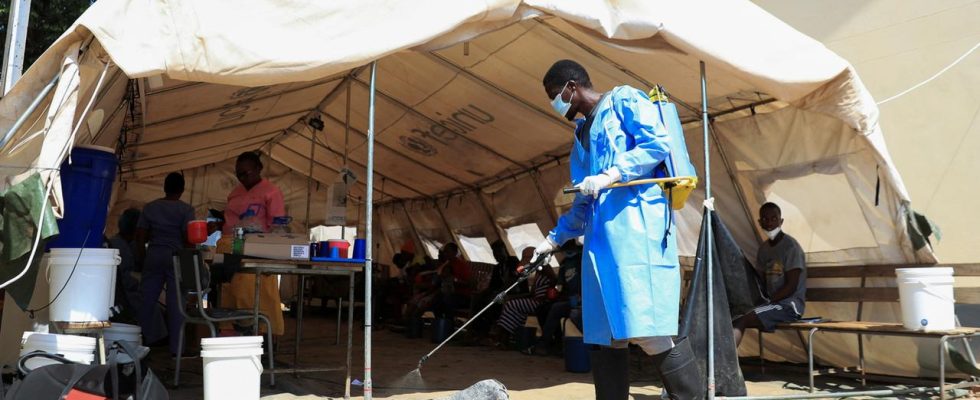Zimbabwe is battling a cholera outbreak. Since February, more than 200 people have died from the highly contagious diarrheal disease and thousands have become infected. Experts suspect even higher numbers.
In Kuwadzana, a suburb of Harare, sewage flows between the huts. It is water contaminated with E. coli bacteria from burst sewer pipes. Mountains of garbage pile up on the streets. This has been going on for months, says Lucia Rupende, pointing to maggots in the puddles. That’s why she doesn’t let her children go out.
“That’s terrible. Are we animals?” she asks. “It’s unbearable the way we live.” The children would have to stay inside and could not play outside. “We are afraid that they will become infected with cholera,” she says.
Sewage in a stormwater drain in Chitungwiza, Harare Province
Diarrhea and vomiting for days
40 percent of cholera cases in the capital are currently reported in the suburb of Kuwadzana. People with little money live there. Stephen Masvingo keeps himself afloat with a barbershop. His salon made of sheet metal and boards has no water connection.
He is happy to have survived cholera. He said he had diarrhea for three days and had to vomit. “I thought it would go away. But I couldn’t keep anything down.” He felt very weak. “Then my wife got help and I went to the hospital straight away.”
Stephen Masvingo believes he was infected by a customer. Sometimes you just forget to wash your hands – and eat then something or bite your nails.
A nurse treats cholera patients. Many sick people don’t go to the doctor, and some don’t have any symptoms.
Wastewater mixes with drinking water
In Zimbabwe, as well as in the neighboring countries of Mozambique and South Africa, there are repeated cholera epidemics because the water and sewage pipes are dilapidated. Regina Feint works for Welthungerhilfe in Harare. She reports that not every household has its own toilet. “And some of the shared toilets are in poor condition. That means people sometimes just go behind the house.”
The next rain will take it away. The smelly wastewater that surrounds Lucia’s Rupende’s hut ends up flowing through a stream into the Chivero reservoir, Harare’s most important drinking water reservoir. The coli bacteria can also be detected here.
A third are poorly nourished
The diarrhea pathogen finds victims particularly easily in southern Africa. The nutritional situation in Zimbabwe is already very tense; around 30 percent of the population is poorly fed. In such countries, “such a disease is a huge problem that ultimately exacerbates hunger.”
So far, the government estimates there are 9,400 cases of cholera in Zimbabwe. But that’s probably just the tip of the iceberg. Many people don’t go to the doctor, some don’t have any symptoms but still pass on the disease.
Concern about further spread
As early as mid-November, the head of the city’s health authority declared that the situation in Harare was getting out of control. The government and aid organizations distributed chlorine tablets, soap and clean water from tank trucks. But if the rainy season begins now, many fear the situation could become as bad as it was 15 years ago. More than 4,000 people died in Zimbabwe in the last cholera epidemic in 2008.
Women fetch clean drinking water from a borehole at the Kuwadzana Polyclinic in Harare. The city’s health authority suspects that many waterholes and fountains are already contaminated.
In Kuwadzana, street vendors sell fish and meat, swarmed by flies. The government actually wants to ban this in order to prevent possible infection. A little further on, people are queuing in front of a waterhole. They are only one to two meters deep and open. The only water they have access to here when no tanker truck comes by.
“We only have one water hole for the whole neighborhood,” says one man. One woman reports: “We sometimes stand in line here for four hours, sometimes for six hours.”
No solution without clean water
The Harare Health Authority estimates that half of these shallow waterholes in the western districts are now contaminated with E. Coli and all of the deep wells. But as long as there is no clean water for everyone, cholera will remain a massive problem in Zimbabwe.
Sheila Chimanya, as health officer in Kuwadzana, tries to make it clear to everyone how they can protect themselves, with hygiene and chlorine tablets for every water. “But it’s hard, people here don’t know what to do anymore.”
Karin Wehrheim, ARD Johannesburg, tagesschau, November 29, 2023 1:10 p.m

